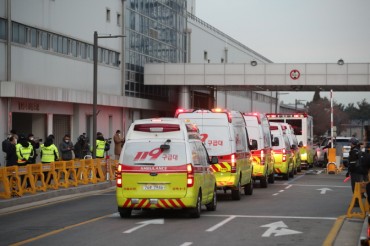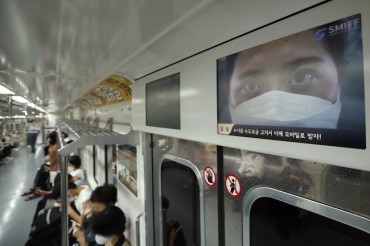
The Korea Aerospace Research Institute conducts a test on a 75 ton thrust engine for its Korea Space Launch Vehicle-2 rocket. (Photo courtesy of KARI) (Image : Yonhap)
GOHEUNG, Feb. 1 (Korea Bizwire) - South Korea is on course to test launch its next-generation space rocket in late 2016 after it made headway in resolving a major technical obstacle that could have led to delays, the head of the country’s aerospace research institute said Sunday.
In a meeting with reporters at the Naro Space Center in Oenaro Island 485 kilometers south of Seoul, Korea Aerospace Research Institute (KARI) head Cho Gwang-rae said the incomplete combustion issue that had plagued the locally built 75 ton thrust engine to be used on the Korea Space Launch Vehicle-2 (KSLV-2) is gradually being overcome.
After launching the Naro-1 space rocket in Jan. 30, 2013, South Korea has been working on a follow-up unit that will take to the sky in 2020 following a limited test flight next year.’
This target has been challenged because uncontrollable fluctuations in pressure and temperature within the rocket engine system caused incomplete fuel combustion. This could potentially lead to the rocket exploding as it tries to lift off from the launch pad.
“Tests conducted last week have led to satisfactory results,” the scientist said. He hinted that after conducting related tests from October onwards, KARI engineers were able to iron out a lot of the problems.
“Technically, we are on the right course,” the former head of the Naro-1 rocket research and development (R&D) team said.
The 47.2 meter-long three-stage KSLV-2 rocket is to be South Korea’s first locally designed and built space vehicle. It will be used to place unmanned satellites into the Earth’s orbit and other commercial purposes.
The Naro-1 rocket was only partially made in the country, since the first stage was brought in from Russia. Local scientists and engineers built the second stage rocket and the satellite.
Related to next year’s test launch, other KARI officials said that of the three stages, only the second and third will actually be tested.
The KSLV-2′s first stage is made up of four individual 75 ton thrust engines, with the second stage being a single 75 ton unit and the third a 7 ton rocket.
“The goal for the 2016 test is to see if the 75 ton engine works according to design,” an official said. He added that the success rate for a country launching its first rocket stands at 33-34 percent, while even for established space rocket builders the success rate only stands at 93 percent for any launch.
KARI then said that because it is conducting ground tests, one actual flight test of the rocket should be sufficient to see if all systems work when they are put under real launch stress and conditions.
It then said at present, only one launch is planned under the 2015-2018 timetable, although if the launch fails, it may have to contemplate another test launch.
“Rocket launches are very costly in terms of materials and human resources,” the state-run institute said.
On the country’s plans to send a unmanned probe to the moon, KARI said that the program involves a locally built probe being sent to the Moon on a foreign-made rocket in 2018. It said the moon mission and the KSLV-2 are not linked at present.
For a South Korean rocket to send a probe to the Moon, it must be much larger, and may have to be a four-stage rocket, since three stages are just not powerful enough the propel a probe all the way to the Moon.
(Yonhap)






